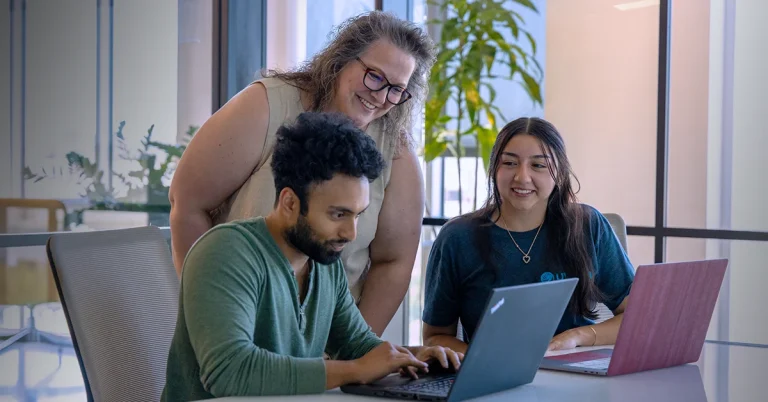By Teresa Mauk, MSN, RN, and Shanna R. Ingram, BSN, RN
Finding creative ways to foster engagement and excitement for learning in the virtual classroom can be challenging, but it’s necessary for creating an environment of familiarity, togetherness, and shared goals.
Impactful faculty interaction and creating a sense of social presence in which learners feel connected to their faculty and peers is key.
Perhaps this is why interaction with faculty and collaboration between students are two of the best practices in distance education for undergraduate nursing education cited in Chickering and Gamson’s (1987) seminal work.
Connections involving visualization and engaged discussion help build a rapport with and between learners, similar to what naturally occurs in the traditional classroom. There are many ways to cultivate connection in the virtual classroom environment; here are a few worth noting.
Set the tone from the start.
Whether the first day of class is online or in person, everyone has first-day jitters; however, introductions in the virtual environment can present new challenges. In addition to technological delays or hiccups, many learners choose to leave their cameras turned off, play with a pet on camera, or engage in social media during class.
In other words, instructors are competing against many new distractions in the virtual classroom. It is also more difficult to read nonverbal cues in the online environment.
To maintain learner attention, allow all classroom participants to get to know each other better, and ensure everyone starts off on equal footing, there are many engaging introductory activities that instructors can use. For example:
- Create a short (2-3 minute) video introduction of course faculty.
- Ask learners to submit short video introductions and post them to the learning management system.
- Schedule a synchronous meeting (or several smaller meetings held at various times to accommodate learner schedules) for course orientation and syllabus review.
- Provide a fun ice-breaking activity during an introductory synchronous meeting.
Although developing community in the online environment may seem daunting or even awkward at first, consistent opportunities for collaboration in which participants can engage with each other in a safe, open, and respectful environment will help you and your students feel connected.
Furthermore, humanizing the online environment with frequent visualization and communication fosters social presence between faculty and students and can minimize learner detachment.
Consistency is key.
Once you have established the right environment, it is important to maintain a connected culture throughout the course. Ongoing interactive strategies include:
- Learning students’ names and conversing with them as they enter the virtual classroom
- Class announcements enhanced with video or audio
- Video-enhanced office hours
- Posting open-ended prompts on a discussion board and providing thought-provoking questions and feedback to student responses (e.g., relatable articles, polls, trivia, current events)
Learning is a team sport.
Nursing is a team sport, and so is learning. It is important for learners to become comfortable collaborating with their faculty and peers in the classroom and clinical environments if they are to be effective members of the healthcare team. You can foster collaboration in a variety of ways:
- Creating small learner groups that complete collaborative assignments such as unfolding case studies
- Holding synchronous meetings (think coffee shop) with small groups for open-ended conversations
- Providing a dedicated area for peer-to-peer communications
Provide prompt feedback.
As in the classroom, providing prompt, specific, educationally rich, and individualized feedback is vital to student success. Learners require feedback to understand how they are progressing in the course and in what areas they need to remediate.
Taking the time to provide robust feedback also teaches lifelong learning skills, ensures learners understand faculty expectations, and communicates care and connection.
When providing feedback in the online environment,
- Maintain consistency in all communications—emails, posted questions, and course work.
For example, many instructors use the A-B-C approach when responding to online discussions.
A – Acknowledge the learners’ contribution to the discussion.
B – Build on the learners’ contributions by clarifying misunderstandings, sharing additional resources or insights, or providing a different perspective.
C – Conclude your comments with a follow-up question that promotes further exploration and discussion.
- Plan or schedule how and when feedback will occur.
For example, you might post a video-enhanced weekly update for learners that highlights what learning objectives were met, areas where they need to continue to focus, key takeaways, and additional resources.
The ideas outlined above are simple ways to foster a sense of community and engagement in a virtual classroom. As we know, engaged students are satisfied students, and satisfied students tend to remain focused on learning.
Do you have other ideas for promoting connection and engagement in the virtual classroom? If so, we would love to hear from you.





